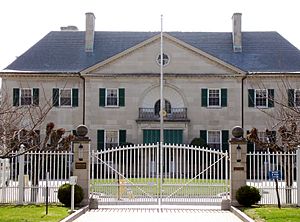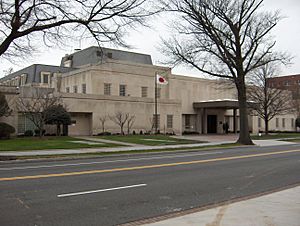Embassy of Japan in Washington, D.C. facts for kids
Quick facts for kids Embassy of Japan |
|
|---|---|
 |
|
| Location | Washington, D.C. |
| Address | 2520 Massachusetts Avenue NW |
| Coordinates | 38°54′56″N 77°3′22″W / 38.91556°N 77.05611°W |
| Ambassador | Shinsuke J. Sugiyama |
|
Japanese Embassy
|
|
| Built | 1931 |
|---|---|
| Architect | Delano & Aldrich |
| NRHP reference No. | 73002092 |
| Designated | February 20, 1973 |
The Embassy of Japan in Washington, D.C. (在アメリカ合衆国日本国大使館, Zai Amerika Gasshūkoku Nihonkoku Taishikan) is Japan's main office in the United States. It is where Japanese diplomats work to keep a strong relationship between Japan and the U.S. The embassy is located at 2520 Massachusetts Avenue NW in Washington, D.C. This area is known as Embassy Row, where many countries have their embassies. Besides its main role, the embassy also helps Japanese citizens living in District of Columbia, Virginia, and Maryland.
Contents
Who is the Ambassador of Japan to the U.S.?
The Ambassador of Japan to the United States is Japan's top representative in the U.S. They are like the chief diplomat. The current Ambassador is Shinsuke J. Sugiyama. He started his role in March 2018.
Past Japanese Ambassadors to the U.S.
Before Mr. Sugiyama, Kenichirō Sasae served as Ambassador from November 2012. And before him, Ichirō Fujisaki was the Ambassador from 2008 to October 2012.
Discover the Embassy Building's History
The embassy building was designed by an American company called Delano & Aldrich. One of the main architects, William Adams Delano, was a distant relative of President Franklin D. Roosevelt. It is said that Emperor Hirohito himself approved the design. The building's plans were officially approved in September 1930.
Architecture and Original Design of the Embassy
The embassy was built in 1931. Its style is called Georgian Revival, which looks like older American colonial homes. But it also has some subtle touches of Japanese architecture.
When it was first built, the embassy had several parts. It included the Ambassador's home, two office buildings (called chanceries) with Japanese design, a tea house, and even sports facilities. The front of the building has a charming cobblestone courtyard and driveway. The original Ambassador's home is now known as the Old Ambassador's Residence. It is located at 2516 Massachusetts Avenue NW.
The original embassy and the two chancery buildings are about two-and-a-half stories tall. They also have two underground levels. The total height of these buildings is about 9.4 meters (31 feet). The chancery buildings facing Massachusetts Avenue NW are about 30 meters (98 feet) wide. The embassy grounds were designed to blend in with Rock Creek Park, which is right behind them. Building the embassy cost about $500,000.
Embassy's Role During World War II
After the attack on Pearl Harbor in December 1941, the U.S. government used the embassy building for a while. It was returned to Japan in April 1952.
Japanese Garden and Teahouse at the Embassy
In 1959, Ambassador Koichiro Asagai and Tatsunosuke Takasaki, a member of Japan's Parliament, suggested building a special garden. They wanted to create a smaller version of the famous rock garden at Ryōan-ji in Japan. This garden was built to celebrate 100 years since the first Japanese embassy came to the U.S. It was finished in 1960. Behind the rock garden, there is a small teahouse called Ippakutei. It is built in the style of the Katsura Imperial Villa in Japan.
The Japanese Embassy was added to the National Register of Historic Places on February 20, 1973. This means it is recognized as an important historic site.
The Modern Chancery Building
A new, modern office building, called a chancery, was finished in 1986. A chancery is where the main offices of an embassy are located. This new building was planned after a U.S. law in 1982 made it easier for embassies to expand. The design for the new chancery was approved in June 1983. It was designed by architect Robert B. Anderson. Local community groups liked the design because it kept the historic feel of the embassy area. This new building brought together embassy offices that were previously in two different rented buildings.
The chancery has 250 underground parking spaces. There is also a tunnel from Waterside Drive that leads to the underground garage. This provides a more secure way for important diplomats or visitors to enter.
Important Visits to the Embassy
Several U.S. Presidents have visited the Japanese Embassy. President Jimmy Carter visited on June 16, 1980. On March 17, 2011, President Barack Obama visited the embassy. He went there to share his sympathy after the big 2011 Tōhoku earthquake and tsunami in Japan.


